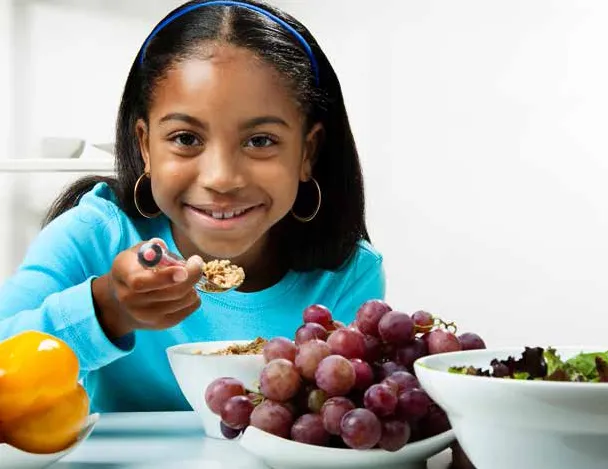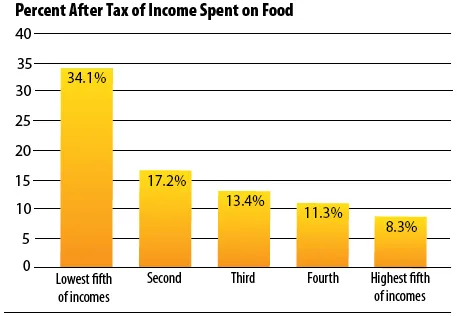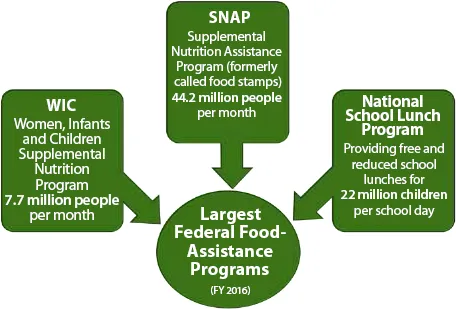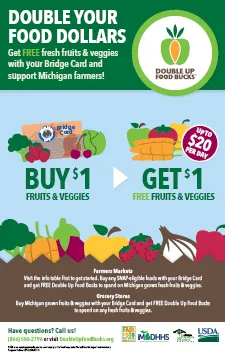![]()
OPTION 1
©ISTOCK.COM/THOMAS_EYEDESIGN
Improve Access to Nutritious Food
“I will always let them eat before I eat,” said Neidra Dowe, a wife and mother of three in Pontiac, Michigan.
The Dowe family had to tighten their belts after disability forced Neidra to leave her job. Her husband had only been able to find part-time work. They did their best to piece together what they needed from his paycheck, her monthly disability allowance, and public-assistance programs like SNAP (formerly food stamps) and Medicaid. They strived to cook nutritious meals and shop for bargains at the grocery store. Still, Dowe knew that, by the end of each month, there might not be enough food to go around. Her story is featured in Small Plates: Five Personal Stories of Food Insecurity in Metropolitan Detroit, published by the Gleaners Community Food Bank of Southeastern Michigan on the Fair Food Network website.
The Dowe family’s story is all too common. According to the USDA study Household Food Security in the United States in 2015, almost 15.8 million US households—about one in eight—experienced food insecurity, which means they don’t have consistent access to the food they need to lead healthy, active lives. The odds are the worst for households with children, especially single-parent families. Black and Hispanic households, with and without children, also have higher rates of food insecurity.
Source: USDA, Food spending as a share of income declines as income rises, 2014
The consequences of food insecurity are far reaching, affecting our health, daily activities, relationships, and sense of well-being. It undermines children’s success in school and the safety and productivity of workers. Hunger in America, a 2011 study by the Center for American Progress, estimated that hunger costs our nation at least $167.5 billion annually in lost economic productivity, poor educational outcomes, avoidable health-care costs, and contributions from private food charities.
The chief barrier to food access is affordability. While the cost of food is relatively low in the United States, it consumes a painful chunk of the annual incomes of low-income families—more than a third for the poorest 20 percent of households. The wealthiest 20 percent spend only a tenth of their incomes on food, according to the USDA Economic Research Service.
Food-assistance programs range from local food pantries and kitchens to national programs for people who are income-eligible. Like the Dowe family, most households receiving federal food assistance include employed adults, but they don’t earn enough money to make ends meet.
The largest federal food-assistance programs include the Supplemental Nutrition Assistance Program (SNAP), the Women, Infants and Children (WIC) supplemental nutrition program, and child nutrition programs. SNAP (formerly called Food Stamps) helps low-income people afford a nutritionally adequate diet. WIC provides nutritious foods, nutritional counseling, breastfeeding support, and health-care referrals to low-income women, infants, and children. Child nutrition programs include free and reduced school lunches and other food programs in schools, child-care centers, and after-school programs.
The availability of grocery stores and the transportation needed to reach them are additional obstacles, particularly in rural and low-income communities. The USDA estimated that 2.1 million US households are more than a mile from a supermarket and do not have a vehicle.
Despite the challenges, Dowe does what it takes to feed her family with the resources available to them. “We’re a bit more health conscious than most people are. Eating well means making concessions in other areas. It may not always be what we want to eat, but it’s there.”
Source: USDA Food and Nutrition Service Programs (RNS) data tables, 2016
Strengthen Federal Food Safety-Net Programs
SNAP, the largest federal food program, serves households with incomes that are less than 130 percent of the federal poverty level. Two-thirds of all SNAP benefits are paid to households with children. The vast majority of SNAP recipients are individuals who are working, are looking for work, are unable to work (due to disability or dependent-care responsibilities) or are not expected to work (because they are children or seniors).
In a 2015 report, the White House Council of Economic Advisors cited a growing body of research on the effectiveness of SNAP in reducing food insecurity. The advisors also expressed concerns that “the current level of benefits often cannot sustain families through the end of the month. Recent research suggests that modestly higher benefit levels would lead to further reductions in food insecurity, and to a wide range of additional short-run and long-run health, educational, and economic benefits.”
Only three-quarters of people eligible for SNAP are enrolled. Community organizations are using a variety of strategies to reach out and enroll eligible families and help SNAP recipients stretch their food budgets. One such effort is a program started by Michigan-based Fair Food Network in 2009. The Double Up Food Bucks program doubles the value of SNAP benefits spent at participating farmers’ markets and grocery stores, helping families bring home more fruits and vegetables while supporting local farmers. The program has since grown to more than 200 sites in Michigan and is being implemented by partners in dozens of states across the country.
IMAGE COURTESY OF FAIR FOOD NETWORK
Bring More Fresh Food into Low-Income Communities that Lack Grocery Stores
People across the country are experimenting with ways to provide fresh food to communities that lack access to grocery stores. Examples include:
•Community Supported Agriculture (CSA), where a community of individuals pledges support to a farm operation in advance and, in return, receives shares in the farm’s bounty throughout the growing year.
•Local gl...





